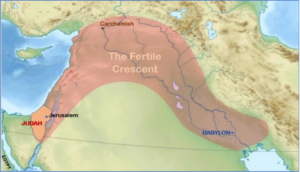HISTORICAL BACKGROUND:

This victory gave Babylon supremacy in the area know as the Ancient Near East (ANE).
With Babylon’s victory, Egypt’s vassals, which included Judah, passed under Babylonian control. Later that same year (605 B.C.) Nabopolassar died, and Nebuchadnezzar became king of Babylon.[5] After his father’s death on August 16, 605, Nebuchadnezzar returned to Babylon and ascended the throne within three weeks.[6]
After the victory at Carchemish, Nebuchadnezzar invaded Judah[7] and attacked Jerusalem.[8] He made Jehoiakim a vassal king of Babylon and to demonstrate his dominance, Nebuchadnezzar took many of Jerusalem’s wisest men and most beautiful women to Babylon as captives. Daniel was among this group (Dan. 1:1-3). Among Nebuchadnezzar’s spoils were some of the vessels from Solomon’s temple (2Chro. 36:7; Dan. 1:2). This was to be the first of three deportations of the Jews from Judah into Babylon. The second deportation took place in 597 B.C. when King Jehoiakim refused to pay tribute to Babylon. Nebuchadnezzar invaded Judah to quash the rebellion[9] and took a second wave of 10,000 captives were deported to Babylon from Judah.[10] This is when the Prophet Ezekiel was taken captive (2 Kings 24:10-17). Jehoiakim died during the siege of Jerusalem and his son Jeconiah became king of Judah. He reigned for 3 months and then was removed from the throne by Nebuchadnezzar. At this point Mattaniah, son of Josiah, was put on the throne by Nebuchadnezzar to rule as a vassal king. Nebuchadnezzar changed his name to Zedekiah (2 Kings 24:8–17). Approximately 10 years later in 586 B.C.,[11] Nebuchadnezzar again attacked Jerusalem and burned it to the ground and destroyed the Temple. He took a third wave of captives back to Babylon.
SUMMARY AND OUTLINE OF DANIEL: Daniel, the main character from whom this book gets its name, was probably only a teenager when he arrived in Babylon in 605 B.C. In the book of Daniel, the Lord orchestrates events to prepare Nebuchadnezzar to know Him. In a series of dramatic experiences—the dream of chapter 2, the remarkable deliverance from the fiery furnace in chapter 3, and the dream of chapter 4. All of these experiences demonstrated the knowledge, power, and authority of Daniel’s God to the king. Then, Nebuchadnezzar recognized that the God of heaven was not only Omniscient but Omnipotent.[12] Thus, the book of Daniel gives a clear demonstration of the principles according to which God’s wisdom, power, and authority work through the history of nations for the final establishment of His divine plan.
The book easily divides into two large sections:[13]
1. DANIEL’S LIFE (1:1—6:28)
Daniel and his three friends chose not to eat the king’s food. They did not bow down to the king’s image, even under penalty of death. Daniel continued to pray even though he knew he might be noticed and sentenced to death. These men are inspiring examples for us of how to live godly lives in a sinful world. When we face trials, we can expect God to also be with us through them. May God grant us similar courage to remain faithful under pressure.
2. DANIEL’S VISIONS (7:1—12:13)
These visions gave the captives confidence that God is in control of history. They were to wait patiently in faith and not worship Babylon’s gods or accept their way of life. God still rules over human activities. Evil will be overcome, so we should wait patiently and not give in to the temptations and pressures of the sinful way of life around us.
[1] Egypt invaded Judah and deposed king Jehoahaz (2Kings 23:33, 23:34; Jer. 22:10-12), setting his eldest son, Eliakim, on the throne in his stead. The Egyptians changed his name to Jehoiakim.
[2] A vassal state is any state that is subordinate to another. The vassal is usually required to pay some sort of tribute to the dominate state.
[3] Also called “the land of the Chaldeans” (Jer. 24:5; Ezek. 12:13)
[4] In about 630 B.C. Nabopolassar established the Neo-Babylonian Empire and become Babylon’s first king in 625 B.C.
[5] Nebuchadnezzar ruled Babylon some 43 years from 605 BC until approximately 562 BC.
[6] Nebuchadnezzar II king of Babylonia. https://www.britannica.com/biography/Nebuchadnezzar-II
[7] It was the third year of Jehoiakim
[8] It is now September of 605 B.C.
[9] The Babylonian Chronicles confirm this, and provide an exact date for the conquest of Jerusalem (597 B.C.)
[10] 2 Kings 24:14-16; Jeremiah 24:1. “There’s no reason to doubt that this really happened,” says Frahm of both the first Babylonian siege in 597 B.C.E. and the second in 587 B.C.E. “On both occasions, many people in Jerusalem were in fact taken into exile, including the royal family.” https://history.howstuffworks.com/history-vs-myth/nebuchadnezzar.htm
[11] Zedekiah (originally known as Mattaniah) was probably in the 9th year of his reign as king in Judah when the initial attack came.
[12] https://www.planobiblechapel.org/tcon/notes/html/ot/daniel/daniel.htm
[13] The following section discussions are from the Life Application Study Bible (LASB, Introduction to the Book of Daniel.